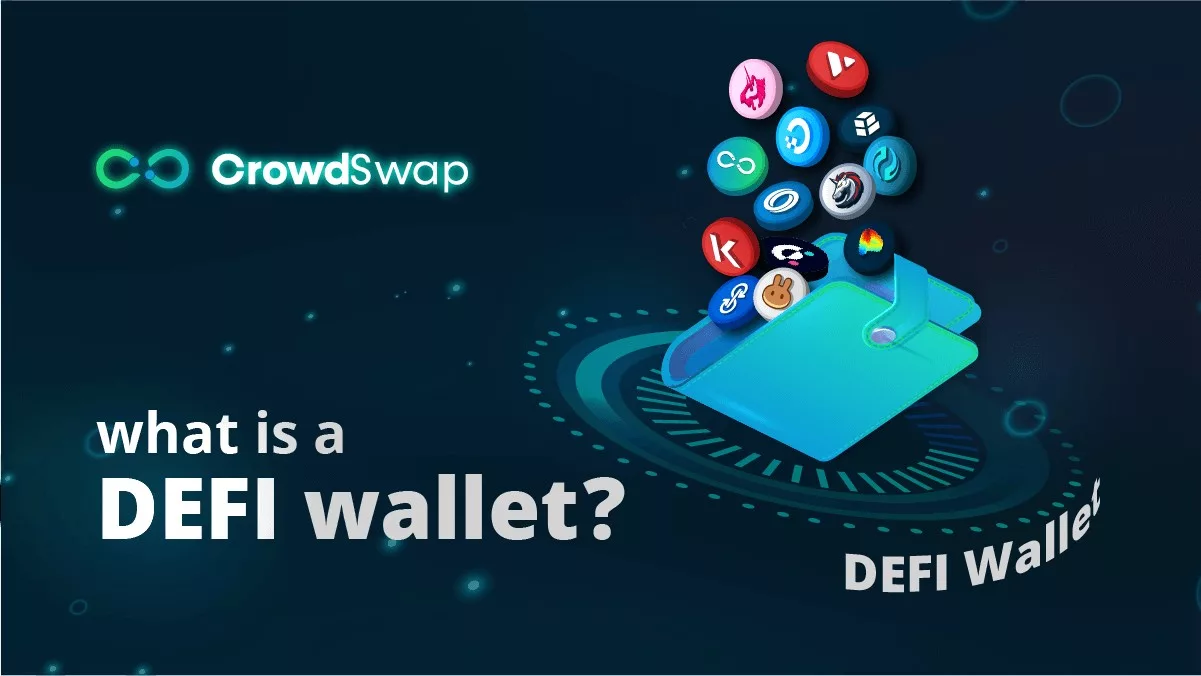Introduction
Decentralized finance (DeFi) has emerged as a disruptive force in the world of finance, offering new opportunities for individuals to participate in a more open, transparent, and decentralized financial system. DeFi protocols are built on blockchain technology, enabling users to interact with financial applications and services in a trustless, peer-to-peer manner.
Suggested read: What is DeFi?
As the DeFi ecosystem continues to grow, it’s important for individuals to understand the key tools and technologies that are required to participate. One such tool is the DeFi wallet, which is a critical component for anyone who wants to engage with DeFi protocols and services. In this article, we’ll explore what a DeFi wallet is, how it works, the best of them, how to keep them safe and why it’s important for anyone looking to get involved in the DeFi space.
What Is Crypto DeFi Wallet?
A DeFi wallet is a digital wallet that is specifically designed to interact with decentralized finance protocols and applications. Unlike traditional storages, which are typically designed to hold a single currency, these kinds of wallets support a range of cryptocurrencies and tokens, enabling users to seamlessly perform crypto swaps between different assets.
One of the key benefits of using a DeFi wallet is that it gives users more control over their funds. With such storages, users hold the private keys to their assets, which means they have complete ownership and control over their funds. Additionally, DeFi wallets typically offer better security and privacy features than traditional wallets, helping to protect users from hacking, theft, and other security risks.
Another key feature of DeFi wallets is their ability to interact with DeFi protocols and services. These storages are often integrated with decentralized crypto exchanges (DEXs), lending platforms, and other DeFi applications, making it easy for users to access and use these services directly from their wallets. This can help to streamline the user experience and make it easier for individuals to participate in the DeFi ecosystem.
Overall, a DeFi wallet is an essential tool for anyone looking to participate in the world of decentralized finance. Whether you’re interested in trading cryptocurrencies, earning interest on your assets, or participating in other DeFi services, a DeFi wallet is the key to accessing these opportunities securely and conveniently.
Types of DeFi Wallets
There are several types of DeFi wallets, each with its own unique characteristics and features. Typically, there are hardware wallets (called cold wallets) and software wallets (called hot wallets).
- Hardware wallets: Hardware wallets are physical devices that are designed to securely store private keys and other sensitive information. They are typically considered to be one of the most secure ways to store cryptocurrencies and are popular among users who prioritize security. However, hardware wallets can be more expensive than other types of wallets.
- Software wallets: Software wallets are applications that are installed on a computer or mobile device. They are typically easy to use and can be a convenient option for users who need frequent access to their funds. However, the downside of software wallets is that they can be vulnerable to security risks, such as hacking and malware attacks.
When choosing a wallet, it’s important to consider the trade-offs between convenience, security, and accessibility. Hot wallets may be more convenient, but they come with higher security risks, while cold wallets may be more secure, but they can be less convenient for day-to-day transactions. Ultimately, the type of wallet you choose will depend on your individual needs and preferences.
What Is the Best DeFi Wallet?
Now that we have discussed the general features of DeFi wallets and the types, let’s dive into some specific examples of the best ones currently available. While the “best” DeFi wallet ultimately depends on your specific needs and preferences, there are several wallets that consistently rank highly among users and offer a comprehensive set of features.
- MetaMask: MetaMask is a popular browser extension wallet that supports multiple blockchains and provides seamless integration with various DeFi protocols. It offers a user-friendly interface, easy access to decentralized exchanges, and robust security features. With MetaMask, you can securely manage your funds and interact with DeFi applications directly from your browser.
- Trust Wallet: Trust Wallet is a mobile wallet that provides a simple and intuitive user experience. It supports both iOS and Android devices, allowing you to manage your DeFi assets on the go. Trust Wallet offers a built-in DApp browser for seamless interaction with DeFi protocols, along with features like staking and token swapping.
- Atomic Wallet: Atomic Wallet is a multi-chain wallet that supports a wide range of cryptocurrencies, making it suitable for users with diversified DeFi portfolios. It offers a user-friendly interface, built-in exchange functionality, and staking capabilities. Atomic Wallet also ensures the privacy and security of your assets through the use of decentralized atomic swaps.
Remember, the best DeFi wallet for you ultimately depends on your specific requirements, such as the cryptocurrencies you hold, your preferred device, and your desired level of security. It is recommended to conduct thorough research, consider user reviews, and assess the features and compatibility of different wallets before making your decision.
In addition to wallets, there are services offered by DeFi protocols and DEXs that help you manage your funds. One of these tools is portfolio manager, which is a complicated one. CrowdSwap’s portfolio manager is a useful tool that not only shows you your funds, but also proposes a portfolio combination that suits your needs the best. This advanced portfolio manager is accessible through the CrowdSwap App.
Manage your portfolio with CrowdSwap’s advanced portfolio manager
How to use a DeFi wallet
Using a DeFi wallet is relatively simple, but there are a few key steps you’ll need to follow in order to get started. Here’s a general overview of how to use one:
- Choose a wallet: First, you’ll need to choose a DeFi wallet that meets your needs. There are many different wallets available, so it’s important to do your research and choose a reputable provider.
- Install the wallet: Once you’ve chosen a wallet, you’ll need to install it on your computer or mobile device. Follow the instructions provided by the wallet provider to complete the installation process.
- Create a new wallet or import an existing one: Depending on the wallet you choose, you may need to create a new wallet or import an existing one. If you’re creating a new wallet, be sure to follow the instructions carefully and store your seed phrase in a safe and secure location.
- Fund your wallet: Once you’ve set up your wallet, you’ll need to fund it with cryptocurrency. Depending on the wallet you’re using, you may be able to fund it with a variety of cryptocurrencies and tokens.
- Interact with DeFi protocols: Once your wallet is funded, you can start interacting with DeFi protocols and applications. Many wallets offer built-in support for popular DeFi protocols, such as decentralized exchanges and lending platforms.
- Keep your wallet secure: Finally, it’s important to keep your wallet secure by following best practices for cybersecurity and online safety. This includes using strong passwords, enabling two-factor authentication, and avoiding suspicious links and emails.
By following these steps, you can start using your DeFi wallet to participate in the world of decentralized finance. Whether you’re interested in trading cryptocurrencies, earning interest on your assets, or accessing other DeFi services, such a tool is essential for anyone looking to participate in this exciting new ecosystem.
How to Withdraw from Defi Wallet
Once you’ve successfully engaged in decentralized finance (DeFi) and accumulated funds in your wallet, you might be wondering how to withdraw those funds. Withdrawing from a DeFi wallet involves a few key steps to ensure a smooth and secure transaction. Here’s a step-by-step guide to help you navigate the process:
Step 1: Select the appropriate platform or exchange
To withdraw funds from your wallet, you’ll need to identify a platform or exchange that supports the cryptocurrency you wish to convert to fiat currency or another digital asset. Research reputable platforms that align with your needs, taking into consideration factors such as supported currencies, withdrawal fees, and security measures.
Step 2: Connect your wallet
Once you’ve chosen a platform, you’ll need to connect your wallet to that platform. Most platforms provide a simple and secure way to connect popular DeFi wallets like MetaMask or Trust Wallet. Follow the platform’s instructions for connecting your wallet, which often involve granting permission through wallet extensions or scanning QR codes.
Step 3: Choose the asset and amount to withdraw
Now it’s time to specify the asset and amount you want to withdraw. On the platform or exchange, locate the withdrawal option and select the desired cryptocurrency or token. Enter the amount you wish to withdraw, ensuring it aligns with your available balance and any minimum withdrawal limits set by the platform.
Step 4: Review withdrawal details and fees
Before finalizing the transaction, carefully review the withdrawal details. Pay close attention to any associated fees, which can vary depending on the platform and cryptocurrency you’re withdrawing. Some platforms may charge a fixed fee or a percentage of the withdrawal amount. Take these fees into account to ensure they align with your expectations and the value of the funds you’re withdrawing.
Step 5: Verify the withdrawal address
One critical step to prevent loss of funds is verifying the withdrawal address. Double-check that you’re entering the correct address to avoid sending your funds to the wrong destination. Copying and pasting the withdrawal address from the platform or exchange is the safest approach, as it reduces the risk of manual errors.
Step 6: Confirm and initiate the withdrawal
Once you’ve reviewed all the details and confirmed that everything is accurate, proceed with initiating the withdrawal. Depending on the platform, you may need to provide additional authentication, such as two-factor authentication (2FA), to secure the transaction. Follow the platform’s prompts to complete the withdrawal process.
Step 7: Monitor the withdrawal and confirm completion
After initiating the withdrawal, monitor the transaction progress. Many platforms provide transaction tracking features, allowing you to follow the status of your withdrawal. Depending on network congestion and other factors, the completion time may vary. Once the transaction is confirmed and the funds have been successfully transferred to the designated address, you can consider the withdrawal complete.
Remember, it’s essential to exercise caution and follow security best practices when withdrawing from a wallet. Ensure your device and wallet software are up to date, use secure internet connections, and maintain the privacy and security of your wallet credentials. By following these steps and staying vigilant throughout the process, you can confidently withdraw funds and access the value you’ve accumulated through your DeFi activities.
Benefits of using a DeFi wallet
There are several benefits to using a DeFi wallet, including easy access to a wide range of decentralized finance services such as lending, borrowing, trading, and yield farming. With a DeFi wallet, you can participate in these activities directly from your wallet, eliminating the need for intermediaries and traditional financial institutions. Additionally, DeFi wallets offer greater control and ownership over your assets, as you hold the private keys and have full autonomy over your funds. This empowers you to navigate the DeFi ecosystem seamlessly, take advantage of lucrative opportunities, and maximize your potential earnings. These include:
- Control: You have complete control over your assets. You don’t need to rely on a third-party custodian or exchange to hold your funds, which can give you greater peace of mind.
- Privacy: They can provide a high degree of privacy, as they allow you to interact with DeFi protocols without revealing your identity or personal information.
- Accessibility: They are typically accessible from anywhere in the world, as long as you have an internet connection. This makes it easy to participate in DeFi regardless of your location.
- Flexibility: They are designed to be flexible, allowing you to interact with a wide range of DeFi protocols and applications. Whether you’re interested in trading, lending, borrowing, or staking, there’s a DeFi wallet that can meet your needs.
- Transparency: They are designed to be transparent, allowing you to see exactly how your funds are being used and how the protocol operates. This can help you make more informed decisions about how to participate in the DeFi ecosystem.
So, a DeFi wallet is an essential tool for anyone looking to participate in decentralized finance. By giving you greater control, privacy, accessibility, flexibility, and transparency, opting for one can help you unlock the full potential of this exciting new ecosystem.
Is DeFi Wallet Safe?
DeFi wallets empower you with unprecedented control over your assets, giving you the freedom to explore and leverage a wide range of decentralized finance services. These wallets serve as your gateway to the exciting world of DeFi, enabling you to participate in activities such as lending, borrowing, yield farming, and more. As you embark on this decentralized financial journey, it’s crucial to be aware of the unique security considerations that come with the territory. But this freedom comes at a cost! In the realm of DeFi, the responsibility of securing your assets falls squarely on your shoulders. Unlike traditional financial systems where intermediaries provide security measures, DeFi puts the power in your hands. While this offers greater autonomy and eliminates the need to rely on third parties, it also means that you must take proactive steps to protect your funds.
With that in mind, let’s delve into some of the most important security considerations you need to be mindful of when using these useful tools. By understanding these risks and implementing the necessary precautions, you can confidently navigate the DeFi landscape and safeguard your assets from potential threats. The following are some of the most important security considerations when using them:
- Hacking: One of the biggest risks is the possibility of hacking. Because DeFi wallets are connected to the internet, they are vulnerable to hacking attempts. Hackers can attempt to steal private keys, seed phrases, or other sensitive information to gain access to the wallet and its contents.
- Phishing: Another risk is phishing attacks. In a phishing attack, a hacker poses as a legitimate entity (such as a DeFi platform or wallet provider) and attempts to trick users into providing sensitive information. This can be done through fake websites, emails, or social media messages.
- Malware attacks: Malware can be used to gain access to a user’s funds and steal sensitive information. Malware can be hidden in downloads or other software, and can go undetected until it’s too late.
But fear not! It’s not that hard to secure your funds from all these risks. There are some ways that you can make sure you don’t get caught by any of these security issues. To mitigate these risks, you need to take the following steps to secure your DeFi wallet:
- Use two-factor authentication (2FA): Two-factor authentication adds an extra layer of security by requiring a code in addition to a password to log in to a wallet. This can prevent unauthorized access even if a hacker obtains a user’s password.
- Keep private keys safe: Private keys are used to access the funds, and if they fall into the wrong hands, they can be used to steal a user’s assets. Users should keep their private keys safe by storing them offline, in a secure location, and never sharing them with anyone.
- Avoid public Wi-Fi networks: Public Wi-Fi networks can be vulnerable to hacking attempts, making them an unsafe option for accessing a DeFi wallet. Users should avoid using public Wi-Fi networks and instead opt for a secure, private connection.
With all that said, security is a critical consideration when using a DeFi wallet. By following best practices such as using two-factor authentication, keeping private keys safe, and avoiding public Wi-Fi networks, users can help protect their assets and participate safely in the decentralized finance ecosystem.
Trade Effortlessly
Ready to dive deeper? Our crypto exchange is simple and user-friendly, making trading a breeze
Conclusion: Why You Need a DeFi Wallet
DeFi wallets offer a secure and convenient way to participate in the decentralized finance ecosystem. By using them, users can access a wide range of services, such as lending, borrowing, trading, and more, all without relying on traditional financial institutions. In this article, we’ve explored what DeFi wallets are and why they are important. We’ve discussed the various types of wallets available, as well as the features they offer. We’ve also examined the security considerations that users should keep in mind when using these tools. So, if you’re interested in participating in the DeFi ecosystem, a DeFi wallet is a must-have tool. By taking the necessary steps to set up a DeFi wallet and following best practices for security, you can safely explore the many opportunities available in the DeFi space. So don’t hesitate – get started today and see what the decentralized finance revolution has in store for you!













